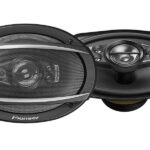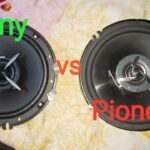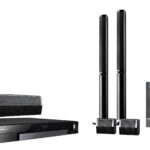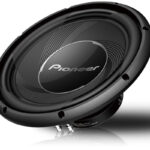Your subwoofer may sound distorted due to incorrect settings or a faulty connection. If you experience distorted sound from your subwoofer, check your settings and connections to resolve the issue.
Common Causes Of Subwoofer Distortion
Subwoofer distortion is a common issue that can significantly impact your audio experience. There are several factors that can lead to distorted sound from your subwoofer. Incorrect placement of the subwoofer can disrupt the sound waves and result in distortion. Ensure that you position it in the appropriate location for optimal performance.
Improper speaker wiring is another culprit behind subwoofer distortion. Make sure that the speaker wires are correctly connected to avoid any electrical interference that may cause distortion.
An overworked amplifier can also contribute to distorted sound. Check if your amplifier is overheating or if the power supply is adequate for the demands of your subwoofer.
Inadequate power supply can cause your subwoofer to struggle to produce clear and undistorted bass. Ensure that your power supply is capable of providing enough power to the subwoofer.
Faulty audio cables can introduce interference and degrade the audio quality, resulting in distortion. Verify that your audio cables are in proper working condition and replace any damaged cables.
Lastly, suboptimal room acoustics can create an unfavorable environment for your subwoofer. Factors such as excessive reverberation or reflections can lead to distorted sound. Consider implementing room treatments or modifying the room layout to improve the acoustics.
Signs Of Subwoofer Distortion
| Signs of Subwoofer Distortion |
| Clipping or Clattering Noise |
| Subwoofer distortion can be identified by a clipping or clattering noise that occurs when the speaker is pushed beyond its limits. This usually happens when the amplifier is unable to handle the increased power demand, resulting in a distorted sound. |
| Muffled or Blurry Sound Output |
| Another sign of subwoofer distortion is muffled or blurry sound output. When the subwoofer is unable to reproduce clear and defined low-frequency sounds, it indicates that the speaker is struggling to accurately reproduce the audio signal. |
| Inconsistent Bass Response |
| A subwoofer experiencing distortion may exhibit an inconsistent bass response. Instead of producing deep and powerful bass notes uniformly, the subwoofer may produce some notes louder or softer than others, resulting in an unbalanced sound. |
| Distorted Low Frequencies |
| Lastly, subwoofer distortion can be identified by distorted low frequencies. Instead of the smooth and clear reproduction of low-frequency sounds, the subwoofer may produce a harsh, distorted sound that lacks definition and detail. |
Troubleshooting Tips To Fix Subwoofer Distortion
In troubleshooting subwoofer distortion, there are several key areas to investigate:
- Recheck the placement of the subwoofer to ensure optimal positioning within the room.
- Verify the speaker wiring connections to eliminate any loose or faulty connections that may cause distortion.
- Assess the power output of the amplifier to determine if it matches the requirements of the subwoofer.
- Consider upgrading the power supply unit to ensure sufficient power delivery to the subwoofer.
- Replace any faulty or aging audio cables that may be contributing to the distortion.
- Lastly, adjust the room’s acoustic treatments to minimize sound reflections and enhance overall audio performance.
By addressing these troubleshooting tips, you can resolve *subwoofer distortion issues*, allowing for *enhanced audio quality* and an immersive listening experience.
Choosing The Right Subwoofer For Your Setup
When it comes to finding the right subwoofer for your setup, it’s important to understand the various specs and features that come into play. Matching the subwoofer power to your amplifier output is crucial for achieving optimal sound quality. Make sure the subwoofer and amplifier are compatible in terms of power ratings.
Another important consideration is the subwoofer size and enclosure type. Larger subwoofers generally produce deeper bass, but they may not be suitable for all setups. Consider the available space and desired sound output when making this decision.
Additionally, room size and listening preferences should be taken into account. A smaller room may require a compact subwoofer, while a larger room could benefit from a more powerful one. Also, consider whether you prefer a sealed or ported enclosure for your subwoofer.
By carefully evaluating these factors, you can ensure that your subwoofer delivers clear and distortion-free bass, enhancing your audio experience.
Setting Up Subwoofer Configuration And Calibration
When setting up your subwoofer, it’s important to properly configure and calibrate its settings to avoid distorted sound. One key aspect to focus on is fine-tuning the subwoofer’s crossover frequency. This refers to the point at which the subwoofer transitions between low frequencies and higher ones, ensuring a seamless blend with the main speakers. Adjusting the subwoofer’s phase is another crucial step, as it controls the alignment of the subwoofer’s sound waves with the main speakers, preventing cancellations or reinforcements. Optimizing the subwoofer’s gain or volume level is also essential, ensuring it complements your main speakers without overpowering them. Additionally, utilizing room correction systems can further enhance the subwoofer’s performance by compensating for any acoustic deficiencies within your listening space.
Maintaining Subwoofer For Long-Term Performance
Regular maintenance of your subwoofer is essential for long-term performance and to prevent distorted sound. Here are some key steps to follow:
- Regular Cleaning and Dusting: Dust build-up can affect the performance of your subwoofer. Wipe the exterior surfaces and gently clean the speaker cone to remove any dust particles.
- Ensuring Proper Ventilation and Cooling: Poor ventilation can cause overheating, impacting the sound quality. Ensure that your subwoofer has enough space for proper air circulation and avoid placing it in enclosed areas.
- Monitoring and Preventing Overloading: Overloading your subwoofer with excessive power can lead to distortion. Be mindful of volume levels and avoid pushing it to its limits.
- Regularly Checking Speaker Connections: Loose or damaged speaker connections can result in distorted sound output. Regularly inspect and secure all connections to ensure optimal performance.
- Periodic Software and Firmware Updates: Manufacturers often release software or firmware updates to improve performance and address potential issues. Stay updated with the latest updates and install them when available.
Conclusion
A distorted sound from your subwoofer can be caused by various factors. Incorrect positioning, inadequate power supply, and incorrect settings are common culprits. By ensuring proper placement, providing sufficient power, and adjusting settings to suit your audio system, you can eliminate distortion and enjoy a clear and powerful bass experience. Take the necessary steps to optimize your subwoofer to enhance your overall audio setup.
Frequently Asked Questions On Why Does My Subwoofer Sound Distorted
Why Is My Subwoofer Producing Distorted Sound?
When a subwoofer is producing distorted sound, it may be due to a damaged speaker cone or a problem with the amplifier. Check the connections, adjust the volume levels, and ensure the subwoofer is not placed too close to walls or corners.
If the issue persists, consider contacting a professional for repairs or replacement.
How Can I Fix Distorted Sound In My Subwoofer?
To fix distorted sound in your subwoofer, start by checking the audio source and cable connections. Adjust the settings on your receiver or amplifier to ensure proper bass management and crossover frequency. If necessary, recalibrate the subwoofer’s volume and phase settings.
If the problem continues, consult a professional for further assistance.
What Causes Subwoofer Distortion?
Subwoofer distortion can be caused by several factors, including incorrect setup, overloading the amplifier, or a damaged speaker cone. Improper positioning of the subwoofer can also result in distorted sound. Ensure the subwoofer is placed in an appropriate location and check the settings on your audio equipment to resolve the issue.








